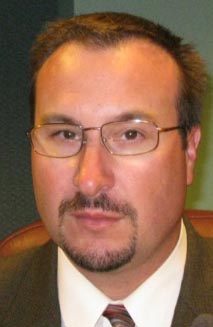Part four: Interview with CSD Manager Jeff Briltz on Templeton drought
-Special from the Soaring Eagle Press-
Part IV – Templeton and the drought. An in-depth interview with Templeton CSD General Manager Jeff Briltz

Jeff Briltz
Note: In Part IV, Briltz talks a little about what steps TCSD is taking to protect Templeton’s water resources and gives an update on the mandated water conservation measures adopted by the State Water Resources Control Board recently– including the impacts on Templeton, district staff’s recommendations regarding the regulations, and an appeal to the town to participate in both conservation and any decisions the board will make on May 19.
Soaring Eagle Press (SEP) – (April 23) We’ve talked about sustainability – now let’s talk about protecting our resources. How is Templeton CSD connected or disconnected with what’s happening here in the North County in regard to water – and what is TCSD doing to protect Templeton’s resources?
Briltz – We have a very active role in the current, very recent changes in the groundwater management landscape. As your readers know, for the last couple of years, there’s been a lot of talk about the formation of a water district for the Paso Robles area – and then last September, three new bills – together known as the Sustainable Groundwater Management Act – were approved and became law. And they provide a whole new regulatory framework for managing groundwater basins and ensuring their sustainability going forward.
TCSD, along with the Atascadero Mutual Water Company, the City of Atascadero, and many other groundwater users and providers in the Atascadero basin are taking an active role in educating our county supervisors and others – informing them that the Atascadero Water Basin is distinct – it is separate from the greater Paso Robles Groundwater Basin.
There’s a little misunderstanding and confusion about just where those boundaries are – the Atascadero Basin behaves rather differently because there’s a fault that separates the Atascadero Basin from the Paso Robles Basin – with, we believe, very little interaction between the two.
And so our education efforts have resulted in the county’s proposal to form the water district in a way that no longer includes those of us in the Atascadero basin – but does include the Atascadero basin – or sub-basin – in what’s considered the sphere of influence but outside the boundaries of the propose district.
In addition, we’ve laid the groundwork to begin to manage the Atascadero basin independently – in compliance with the Sustainable Groundwater Management Act. We’re in regular talks about how to develop our own Groundwater Sustainability Agency (GSA) through a partnership between Templeton Community Services District (TCSD), Atascadero Mutual Water Company (AMWC), the City of Atascadero, and several of the smaller water companies along with landowners that surround us where we share that resource [Atascadero basin].
The purpose of creating that agency would be to develop a Groundwater Sustainability Plan and submit that to the state for its approval and then ultimately to implement that plan to insure the basin’s sustainability moving forward.
We also need to seek some form of formal designation under the Department of Water Resources to designate the Atascadero basin as – maybe more independently than some might believe it is designated today – there’s a misunderstanding about where those boundaries lie – and it might be to our benefit to firm that up.
SEP – Do you have any final thoughts on the issues we’ve been discussing today [April 23rd – Parts I – IV as published in SEP]?
Briltz – Yes, I’d like to call your readers attention to the District’s current water conservation rules and suggest that they really pay attention to what’s under consideration going forward – particularly as it relates to what rules might be considered for the coming year because of the drought. Now, we’ve gotten a lot of conservation out of the revised conservation ordinance that was approved last year through some public education, and a whole lot of people just doing the right thing.
However, on May 19, our board will be considering changes to the district’s water conservation rules for the rest of 2015 – which could include things like going to a no more than a two-day a week watering schedule – a prohibition on washing cars – perhaps consideration of not allowing construction meters or hydrant meters for use on construction projects for dust control, etc. – those are just some of the items under consideration.
And so, those residents interested should pay close attention – and actually – everything you can do to save water between now and then will help the district make decisions going forward. In other words – I believe that the board’s decisions about further conservation measures that become enacted will be in part based on the types of water conservation that we see right now – so the sooner people can implement further conservation at home – use less water – the less likely you’ll have government or regulations telling you how you can use your water.
May 8th Follow Up
SEP – [May 8] In your original interview on April 23rd we talked about the Governor’s water conservation mandate and the regulations that were under consideration by the State Water Resources Control Board. I think, the two things about the draft regulations that stood out in your interview were that (a) Templeton isn’t an urban water supplier – so a great deal of what was in the draft regulations wouldn’t affect what TCSD does, and (b) the town of Templeton must save 25 percent over 2013 – but that there is some leeway as to how the district could go about doing that.
SEP – With that background in place, the first question is – were there any changes in the adopted regulations versus the draft regulations, that directly affect Templeton?
Briltz – Yes, there were – the draft regulations were amended a little bit before they were adopted – and for non-urban water suppliers like us – anyone with less than 3,000 connections – we have two choices.
One is to implement limits on outdoor turf and ornamental watering to no more than two days per week – or cut [water] production by 25 percent – and that sounds very much like the draft.
However, in the draft language the two choices were – implement a 2-day a week watering or implement mandatory conservation measures intended to achieve 25 percent.
So, the change has become a little less vague and a little more specific.
On May 19th, our board of directors will be considering implementing an ordinance change and a resolution implementing tougher water conservation standards – and we
As the regulations look now, if we were to implement other mandatory water conservation measures and not achieve a 25 percent savings at the end of the day, our community would be subject to penalties – and it could be expensive. So although the change is seemingly minor, it might have significant consequences.
SEP – So looking at the verbiage change that essentially went from “implement conservation measures intended to save 25 percent” to “cut water production” to save 25 percent – does that mean the District would turn off the spigot if usage goes over the required savings?
Briltz – No, but that’s the real difficult thing that we have to decide – either implement a watering schedule of 2-days a week or fewer – OR cut production by 25 percent.
So, if we implement the two-day a week watering schedule – which we know won’t be popular for everybody – then while we still have the objective of meeting the 25 percent reduction in production [over 2013] – it may mean that other changes over the course of the summer may not need to be considered in order to comply.
We may still wish to do further conservation, but, in our interpretation, if we implement the two-day a week watering, we will be in compliance with the currently adopted regulations – and that’s one of the key factors that will lead to that specific recommendation to the board.
Again, all the information – the staff report, the ordinance, and resolution are still being drafted and will be available on our website (www.templetoncsd.org) for the public to review in advance of the May 19 meeting.
And I would encourage any of our residents who have a concern or want to weigh in on this to write us, email us, or come to the meeting on May 19th – because I know the board will take their input into consideration.
But we’re not left with a lot of options – and although our residents continue to really do a great job conserving – it would be speculative to assume we could get 25 percent savings between the months of June and November [the reporting period for the new regulations]. Again, last year we did really well at the beginning of the year but kind of petered off as the year went on. And I’m afraid I have some difficulty risking the kind of fines and penalties that the State Water Resources Control Board has at their disposal – if we’re unable to reduce overall production by 25 percent at the end of the day.
Note: For those who missed parts of the series or who would like to review: In Part I, Biltz discussed how the drought has impacted Templeton, where the town’s water comes from and commented on the recent state water conservation mandate – and why Templeton is in a different category than most of the communities affected. In Part II, Briltz shared how well Templeton did in water conservation last year, how much water the community will be required to save this year, and outlined a number of ways to conserve outdoor water use. In Part III, Briltz addresses indoor water conservation and how TCSD is working to sustain Templeton’s water resources.




















